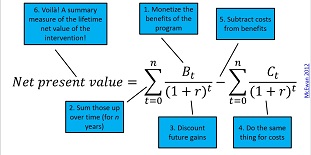Cost-effectiveness Analysis
Cost-effectiveness Analysis is the economic analysis of the costs and benefits of an impact evaluation project.
Read First
- Cost-effectiveness analysis should be included in project design to compare alternative projects.
Guidelines
What is Cost-effective Analysis (CEA)?
CEA summarizes the results of complex program as ratio of costs to effects. It measures the cost for a given level of effectiveness, for example the cost to increase skilled birth attendance by 50 percent or vice versa, for example the percentage gain in skilled birth attendance induced by spending $100. The analysis must accurately reflect the program based on costs and impacts actually observed. It is useful for comparing multiple interventions with common outcome(s) if the costs and benefits are computed using similar methodology for all programs. It is useful for policymakers to compare programs when they are primarily concerned about one outcome of interest (e.g. increasing skilled birth attendance, not maternal and child health broadly)
Difference between Cost-effective Analysis (CEA) and Cost-benefit Analysis (CBA)
CBA compares the monetary value of benefits against costs and hence calculates the ratio of all benefits to the costs of a program. CBA can be useful to determine whether a program is worth the investment. It can also allow comparison across vastly different interventions, for example education versus agriculture. However, CBA requires a number of strong assumptions about the monetary value of all the different benefits, including the lifetime benefits of an intervention.
CEA is transparent, simple, objective and enables comparison of programs with common outcome(s) of interest. However, the implicit assumption is a common post-intervention trajectory.
Use of Cost-effective Analysis in Impact Evaluations
There are very few papers that have undertaken comparative cost‐effectiveness of different programs. Most studies don’t conduct cost analysis. Of the 77 RCTs, 56% reported zero data on incremental costs (McEwan 2014).
Studies that have incorporated CEA include: –Kremer, Miguel and Thornton (2005): Incentives to learn –Banerjee, Cole, Duflo, Linden (2007): Remedial education vs computer-assisted learning However, these were done for the same country / organization
Quantifying Impacts
Calculating Costs
Back to Parent
This article is part of the topic Cost-effectiveness Analysis

